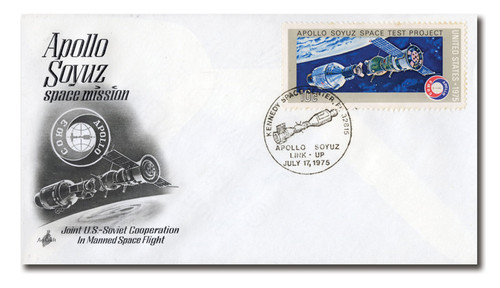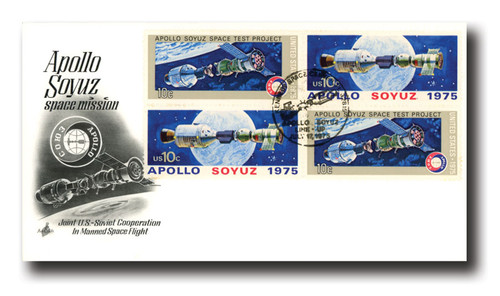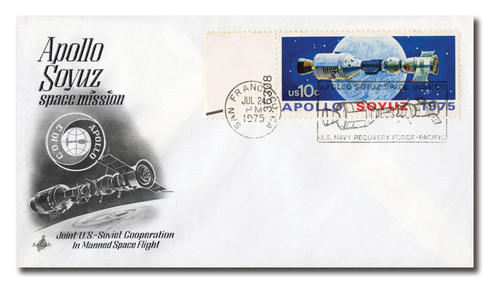
# AC389 - 7/17/1975, Apollo Soyuz Joint U.S.-Soviet Cooperation
Own a Special Event Cover Celebrating the Apollo Soyuz Project –
The First Joint US-Soviet Space Mission
After several years of tension and a Space Race to the Moon, the United States and Soviet Union began to adopt a détente policy. This was an easing of strained relations. Out of this policy came the Apollo-Soyuz Test Project.
As the American and Soviet space agencies worked together, so did their postal administrations. Plans for a joint issue between the nations began in July 1973. The US and Soviet postal agencies worked together to design the stamps. In the end, Robert McCall, who previously did the artwork for the 1971 Space Achievement and 1974 Skylab-Pioneer stamps, was selected to design the “after link-up” stamp. Soviet Artist Anatoly Aksamit designed the “before link-up image.”
The stamps were issued on July 15, 1975, the same day the Apollo and Soyuz spacecraft each launched from their respective countries. This special event cover features a block of four Apollo Soyuz stamps canceled at Kennedy Space Center on July 17, the day both space craft linked up in space. The cachet depicts the linkup over the Earth and the mission patch. This neat cover captured space and world history as it happened! Get it for your collection now.
More about the Apollo Soyuz Test Project
After docking together in space on July 17, the Apollo and Soyuz crews conducted joint experiments, toured each other’s spacecraft, and shared meals. The crews exchanged flags and gifts before separating 44 hours after docking.
The crews continued to work together in space. Apollo maneuvered in front of the Sun to cause the first man-made eclipse, so Soyuz could take photos of the Sun’s corona. The Apollo crew remained in space for six additional days observing the Earth and the universe. The astronauts studied ocean currents and pollution, volcanoes, and iceberg movements. They expanded our knowledge of distant space with the discovery of the first pulsar (or pulsing star) outside our galaxy and evidence that led to identifying the hottest known dwarf star.
The knowledge gained during the mission was valuable future space programs. People from both countries gained a better understanding of each other by witnessing the crews’ interactions on live television feeds.
Own a Special Event Cover Celebrating the Apollo Soyuz Project –
The First Joint US-Soviet Space Mission
After several years of tension and a Space Race to the Moon, the United States and Soviet Union began to adopt a détente policy. This was an easing of strained relations. Out of this policy came the Apollo-Soyuz Test Project.
As the American and Soviet space agencies worked together, so did their postal administrations. Plans for a joint issue between the nations began in July 1973. The US and Soviet postal agencies worked together to design the stamps. In the end, Robert McCall, who previously did the artwork for the 1971 Space Achievement and 1974 Skylab-Pioneer stamps, was selected to design the “after link-up” stamp. Soviet Artist Anatoly Aksamit designed the “before link-up image.”
The stamps were issued on July 15, 1975, the same day the Apollo and Soyuz spacecraft each launched from their respective countries. This special event cover features a block of four Apollo Soyuz stamps canceled at Kennedy Space Center on July 17, the day both space craft linked up in space. The cachet depicts the linkup over the Earth and the mission patch. This neat cover captured space and world history as it happened! Get it for your collection now.
More about the Apollo Soyuz Test Project
After docking together in space on July 17, the Apollo and Soyuz crews conducted joint experiments, toured each other’s spacecraft, and shared meals. The crews exchanged flags and gifts before separating 44 hours after docking.
The crews continued to work together in space. Apollo maneuvered in front of the Sun to cause the first man-made eclipse, so Soyuz could take photos of the Sun’s corona. The Apollo crew remained in space for six additional days observing the Earth and the universe. The astronauts studied ocean currents and pollution, volcanoes, and iceberg movements. They expanded our knowledge of distant space with the discovery of the first pulsar (or pulsing star) outside our galaxy and evidence that led to identifying the hottest known dwarf star.
The knowledge gained during the mission was valuable future space programs. People from both countries gained a better understanding of each other by witnessing the crews’ interactions on live television feeds.











